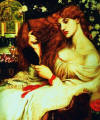100 Greatest Painters Artists Alphabetically Artists by Country Artists by Century Artists by Movement
|
The Pre- Raphaelite Artists Famous Painters Associated With The Pre- Raphaelite Movement
|
|
|
Information About the PRB style of Painting The Pre-Raphaelite Brotherhood (PRB) was founded in 1848. The most important artist of the PRB was a handsome and charming painter named Dante Gabriel Rossetti. Rossetti and his associates, John Everett Millais and William Holman Hunt, rejected Neoclassical and High Renaissance art and embraced the spiritually infused works of the Early RenaissanceByzantine Style and Gothic painters. They sought to create a new artistic style using biblical, mythological, and literary imagery as the subjects of their art-works. Their paintings often contain obscure visual symbols and secret riddles. The term Pre-Raphaelites refers to High Renaissance artist Raphael. Some members of the PRB referred to Raphael's work as slosh and criticized his decadent themes and perverse lifestyle. Raphael, although one of the greatest painters in the history of art, died of syphilis and was known as a drunkard and carouser. This did not sit well with the PRB painters who believed that only a morally pure artist could produce morally pure art. John Ruskin, famous Victorian Art Critic and major influence on the PRB cautioned "The picture which has the nobler and more numerous ideas, however awkwardly expressed, is a greater and a better picture than that which has the less noble and less numerous ideas, however beautifully expressed" |
The Expressionist Art Movement
"To restrict the artist is a crime. It is to murder germinating life." - Egon Schiel
The
Expressionist art movement was conceived in opposition to Impressionism.
The Expressionist painters required emotional drama, pure color and
innovation. Emil Nolde, German, Expressionist Painter observed,
"The art of an artist must be his own art. It is... always a continuous
chain of little inventions, little technical discoveries of one's own,
in one's relation to the tool, the material and the colors."
They
disdained dreamy landscapes, water lilies and Japanese bridges.
Controversial Austrian Expressionist Painter, Egon
Schiele asserted, "I must see new things and investigate them.
I want to taste dark water and see crackling trees and wild winds."
Expressionist painters looked inward at their own emotions, and less
upon the outside world for inspiration. Painters of the Expressionist
generation grew up on the battlefield, witnessing wartime atrocities
and returning to war ravaged countries.
The German Expressionists, George
Grosz,
Ernst
Ludwig Kirchner and
Emil Nolde dominated the art
scene with powerful, emotional work based on the human
struggle and futility of war. Their art-work was born in a world of
confusion and social collapse. James Ensor
declared "My art tends toward the
literary. My pictures tend toward the outskirts of painting: But why
generalize? It is possible to realize one thing or another, according
to the impressions gained from one point of view or another. But it is
too difficult to make a general rule."
Popular Questions About Art
History
What role did Entartete
Kunst play in 20th cetury art?
How did the Black Death impact European art history?
How did the Inquisition impact European art history?
What was the influence of the Medici Academy on Renaissance painters?
How did the Bonfire of the Vanities impact Italian Renaissance?
☼☼☼☼☼
If you feel you have worthwhile information you would like to contribute we would love to hear from you. We collect essential biographical information and artist quotes from folks all over the globe and appreciate your participation. When submitting please, if possible, site the source and provide English translation. Email to historyofpainter@gmail.com
© HistoryofPainters.com 2017
This text is Copyright © historyofpainters.com. Do not use without permission. If you like this page and wish to share it, you are welcome to link to it, with our thanks.
